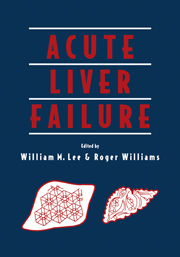Book contents
- Frontmatter
- Contents
- Preface
- Foreword
- Acknowledgments
- Contributors
- Part One Clinical Syndrome and Etiology
- Part Two Mechanisms of Disease and Multisystem Involvement
- Part Three Intensive Care Management
- 10 Medical management of acute liver failure
- 11 Circulatory derangements, monitoring, and management: heart, kidney, and brain
- 12 Brain edema and intracranial hypertension in acute liver failure
- 13 Management of infection in acute liver failure
- Part Four Transplantation
- Part Five Artificial and Bioartificial Liver Devices
- Part Six Other Applications
- Index
- Plate section
11 - Circulatory derangements, monitoring, and management: heart, kidney, and brain
from Part Three - Intensive Care Management
Published online by Cambridge University Press: 20 May 2010
- Frontmatter
- Contents
- Preface
- Foreword
- Acknowledgments
- Contributors
- Part One Clinical Syndrome and Etiology
- Part Two Mechanisms of Disease and Multisystem Involvement
- Part Three Intensive Care Management
- 10 Medical management of acute liver failure
- 11 Circulatory derangements, monitoring, and management: heart, kidney, and brain
- 12 Brain edema and intracranial hypertension in acute liver failure
- 13 Management of infection in acute liver failure
- Part Four Transplantation
- Part Five Artificial and Bioartificial Liver Devices
- Part Six Other Applications
- Index
- Plate section
Summary
INTRODUCTION
Significant hemodynamic changes are seen in acute liver failure (ALF) which resemble those seen in sepsis, including an elevated cardiac output and lowered systemic vascular resistance (Bihari et al. 1986). Patients with critical illness frequently demonstrate a covert tissue oxygen debt despite apparently adequate blood pressure and arterial oxygen saturation (Haupt et al. 1985). In a healthy individual, adjustments are made in pulmonary gas exchange, cardiac output, hemoglobin, oxygen binding, capillary resistance, and oxygen extraction ratio to maintain an adequate supply of oxygen to the cell in the face of changing energy demands. Failure to maintain an adequate oxygen uptake to cells appears to be related to a combination of factors resulting in an inability to regulate delivery and extraction of oxygen at a cellular level.
MICROCIRCULATORY DYSFUNCTION
The basis for the microcirculatory dysfunction in critical illness is poorly understood, but evidence is accumulating to suggest the importance of interactions between the endothelium, exogenous factors, such as bacterial toxins and cytokines, specifically tumor necrosis factor (TNF) and interleukins (IL-1, IL-6). Endotoxin and other bacterial toxins lead to the production of cytokines by activated macrophages and may be maintained in the circulation because of impaired Kupffer cell function. Activation and consumption of platelets with formation of microthrombi within various organs, may lead to endothelial damage and release of further vasoactive compounds. This series of events, together with increased adhesion of activated leukocytes to endothelial cells, causes microcirculatory plugging with blood being shunted through non-nutritive arteriovenous channels.
- Type
- Chapter
- Information
- Acute Liver Failure , pp. 132 - 143Publisher: Cambridge University PressPrint publication year: 1996



